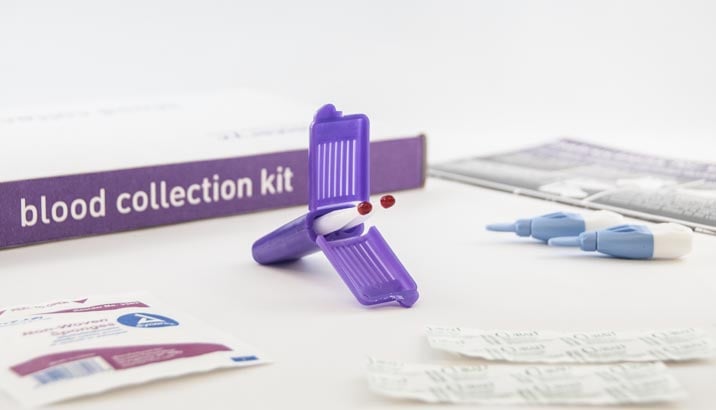Share this
clinical trials: the challenge of volunteer recruitment
by Neoteryx Microsampling on Apr 10, 2019 8:51:00 AM
Clinical trials require a minimum number of study volunteers to be enrolled from start to finish in order to be successful. This requires volunteer recruitment, retention, and engagement. Recruiting volunteers to enroll in a clinical trial is one of the most challenging factors, and one that must be overcome to accomplish trial goals.
Poor recruitment can result in trial delays, which can lead to financial losses. Recruitment of too few test subjects creates the potential for presenting biased results; more test participants are needed in order to present comprehensive and conclusive study results.

Here is why volunteer recruitment presents a challenge to clinical trial managers:
1. Only a small portion of a trial budget goes into study volunteer recruitment.
Recruitment of study participants is as important as any other part of the clinical trial, so setting aside enough money to create awareness and interest in the trial is needed. This ensures the public knows about upcoming clinical trials and how to enroll. The awareness campaign for a clinical trial should also include the importance of the research being done, and the benefits of participation.
2. Many clinical trial participants are primarily interested in money.
Many people enrolling as participants in clinical trials are primarily interested in receiving money for their participation. If the money offered is not enticing enough, or if there is none, few people may be willing to participate.
Clinical trials are important in advancing new treatments for healthcare and improving the health of humans and society. People need to be aware of the impact they might make if a clinical trial presents a new medication that could improve conditions or prevent diseases and change many lives. Letting people know about the impact of their participation in a trial could increase the number of participants, if it's done in a way that really engages people.
3. Recruiting volunteers for condition-specific trials is usually more challenging.
Clinical trials that require healthy individuals are much easier to recruit for compared to those that are trying to recruit patients with specific conditions. Trial sponsors and scientists could target specific facilities that treat the condition in question and ask the practitioners to help create awareness among their pool of patients with those conditions. In these instances, the appeal to join a trial may be early access to a medication that may provide significant health benefits compared to current treatments available.
4. Paperwork can be a deterrent.
Reams of paperwork can deter individuals from participating in clinical trials. Since clinical trials are meant to be experimental, there is some amount of risk involved. This requires a lot of paperwork about safety to be submitted to protect both parties. Simplifying the paperwork process could help in attracting interested individuals.
5. Procedures and potential side effects may be intimidating factors.
Individuals may fear the potential side effects of the new medication that is being trialed, or they may fear the processes and procedures that take place during clinical trials. Participants may be required to frequently collect biological specimens for testing in the lab – usually blood and/or urine samples.
When a trial requires blood collection through venipuncture, for example, this may deter some people from participating. Many people fear needles and blood draws and they would rather avoid a blood collection procedure if at all possible.
 However, with new, minimally invasive blood collection devices available, painful blood draws can be replaced with a quick finger-stick sampling event.
However, with new, minimally invasive blood collection devices available, painful blood draws can be replaced with a quick finger-stick sampling event.
Portable tools like the Mitra® device with VAMS® or hemaPEN® can be provided to clinical trial volunteers in sample collection kits for at-home collection. This remote microsampling approach eliminates the need for a volunteer to travel to the clinic or lab for a blood draw to be performed by a trained phlebotomist.
Letting the trial recruits know about this convenient and practically painless option for sample collection could lead to higher recruitment rates for your clinical trials.
Learn more by visiting our resource page on Microsampling for Decentralized Clinical Trials: 

Image Credits: Shutterstock, Trajan, Neoteryx
Share this
- Microsampling (206)
- Research, Remote Research (119)
- Venipuncture Alternative (105)
- Clinical Trials, Clinical Research (83)
- Mitra® Device (73)
- Therapeutic Drug Monitoring, TDM (51)
- Dried Blood Spot, DBS (39)
- Biomonitoring, Health, Wellness (30)
- Infectious Disease, Vaccines, COVID-19 (24)
- Blood Microsampling, Serology (23)
- Omics, Multi-Omics (21)
- Decentralized Clinical Trial (DCT) (20)
- Specimen Collection (18)
- Toxicology, Doping, Drug/Alcohol Monitoring, PEth (17)
- Skin Microsampling, Microbiopsy (14)
- hemaPEN® Device (13)
- Preclinical Research, Animal Studies (12)
- Pharmaceuticals, Drug Development (9)
- Harpera Device (7)
- Industry News, Microsampling News (5)
- Antibodies, MAbs (3)
- Company Press Release, Product Press Release (3)
- Environmental Toxins, Exposures (1)
- July 2025 (1)
- May 2025 (1)
- April 2025 (2)
- December 2024 (2)
- November 2024 (1)
- October 2024 (3)
- September 2024 (1)
- June 2024 (1)
- May 2024 (1)
- April 2024 (4)
- March 2024 (1)
- February 2024 (2)
- January 2024 (4)
- December 2023 (3)
- November 2023 (3)
- October 2023 (3)
- September 2023 (3)
- July 2023 (3)
- June 2023 (2)
- April 2023 (2)
- March 2023 (2)
- February 2023 (2)
- January 2023 (3)
- December 2022 (2)
- November 2022 (3)
- October 2022 (4)
- September 2022 (3)
- August 2022 (5)
- July 2022 (2)
- June 2022 (2)
- May 2022 (4)
- April 2022 (3)
- March 2022 (3)
- February 2022 (4)
- January 2022 (5)
- December 2021 (3)
- November 2021 (5)
- October 2021 (3)
- September 2021 (3)
- August 2021 (4)
- July 2021 (4)
- June 2021 (4)
- May 2021 (4)
- April 2021 (3)
- March 2021 (5)
- February 2021 (4)
- January 2021 (4)
- December 2020 (3)
- November 2020 (5)
- October 2020 (4)
- September 2020 (3)
- August 2020 (3)
- July 2020 (6)
- June 2020 (4)
- May 2020 (4)
- April 2020 (3)
- March 2020 (6)
- February 2020 (3)
- January 2020 (4)
- December 2019 (5)
- November 2019 (4)
- October 2019 (2)
- September 2019 (4)
- August 2019 (4)
- July 2019 (3)
- June 2019 (7)
- May 2019 (6)
- April 2019 (5)
- March 2019 (6)
- February 2019 (5)
- January 2019 (8)
- December 2018 (3)
- November 2018 (4)
- October 2018 (7)
- September 2018 (6)
- August 2018 (5)
- July 2018 (8)
- June 2018 (6)
- May 2018 (5)
- April 2018 (6)
- March 2018 (4)
- February 2018 (6)
- January 2018 (4)
- December 2017 (2)
- November 2017 (3)
- October 2017 (2)
- September 2017 (4)
- August 2017 (2)
- July 2017 (4)
- June 2017 (5)
- May 2017 (6)
- April 2017 (6)
- March 2017 (5)
- February 2017 (4)
- January 2017 (1)
- July 2016 (3)
- May 2016 (1)
- April 2016 (2)

Comments (1)